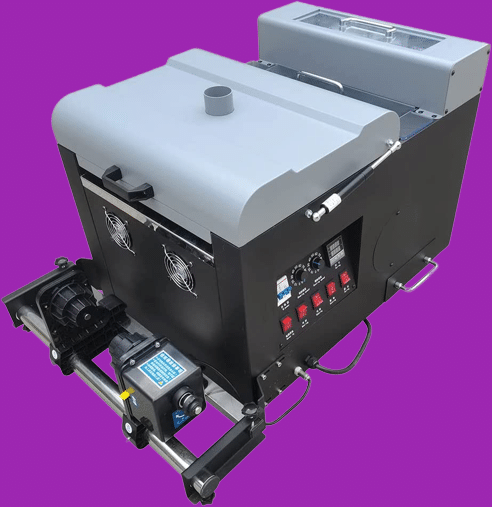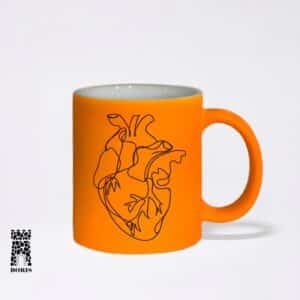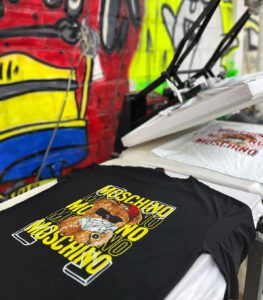DTF printing, also known as direct to film printing, is one of the most exciting inventions that have emerged in the field of printing technology over the years. DTF printing is a game-changer in the field of textile and clothing decorating because it makes it simple to transfer detailed, high-quality patterns onto a variety of textiles, including cotton, polyester, and other materials.
This detailed blog article covers what is needed for DTF printing. If you’re a printing veteran trying to enhance your skills or a newbie eager to explore this disruptive technology, this tutorial will provide you a strong foundation.

We will examine the essential components of DTF printing, including the necessary equipments such as specialized printers, premium inks, and PET films. You’ll learn how to set up your artwork for best results, the details of the printing process, and how to resolve typical problems that could occur.
You’ll be ready to start DTF printing with the knowledge and skills to create amazing, colorful graphics on a variety of materials after reading this article. So, let’s dive in and uncover the world of DTF printing together.
Essential DTF Printing Equipments
- Printer: For DTF printing, you need a special printer that can handle the process’s unique needs. These printers’ precise ink application on DTF film ensures vivid and accurate patterns. To get outstanding results, look for models that provide high-resolution printing and accurate color reproduction.
- Inks: For brilliant, long-lasting prints, premium DTF inks are required. These inks were developed to have good fabric adherence and to endure washing and use. To ensure the durability and print quality of your DTF printer, make sure you use the suggested inks.
- Films: DTF PET films serve as a bridge between the fabric and your printed design. They have to be of the highest caliber possible to provide good ink transfer and adherence. Select the DTF film that is best for your fabric and printer model from the variety of DTF film options available.

- Heat Press: To cure the printed pattern into the cloth, a heat press is necessary. This procedure makes that the ink adheres firmly to the fabric, resulting in a washable and long-lasting product. For dependable results, use a heat press that offers constant pressure and temperature.
Investing in these essential DTF printing equipment components is the first step towards achieving outstanding and long-lasting textile prints.
Additional Tools
- Cleaning kit: Keeping your DTF printing equipment functioning well and surviving a long time requires a cleaning kit. For cleaning important components including printheads and rollers of ink residue, dust, and debris, it normally comprises cleaning agents, wipes, and tools. Regular cleaning ensures consistent print quality, prolongs the life of your equipment, and helps avoid blockages.
- DTF Hot-Melt Adhesive Powder: In the DTF processes, this particular adhesive powder is essential. It serves as a bonding agent between the cloth and the printed pattern on the film. A crucial element of effective DTF printing, the adhesive powder must be applied precisely to produce sharp and long-lasting prints.
- Curing Oven: After the printing process, the ink and glue on the fabric are set with heat in a curing oven. This step is essential for assuring the durability and washability of the design. Invest in a reliable curing oven with consistent temperature and drying periods for the best results.
- Air filter: To avoid contaminating the film or the printing equipment, DTF printing surroundings should be clear of dust. Air filters keep workspaces clean and prevent airborne particles from interfering with printing, resulting in cleaner, more accurate prints.
- RIP Software: Your must convert your design files into a format that the DTF printer can read using RIP (Raster Image Processor) software. It offers sophisticated color management, enables fine control over print parameters, and aids in ink consumption optimization, eventually improving the quality and effectiveness of your prints.
- Powder Shaker and Dryer: We use these tools to apply adhesive powder to the printed pattern uniformly and to wipe away extra powder after curing. For crisp, colorful prints with a delicate touch feel, proper powder application and removal are essential.

- Humidifier/Dehumidifier (Optional): A humidifier or dehumidifier isn’t required, but it can help keep your desk at the right amount of dampness. In places with changing humidity, this could enhance DTF printing and print quality.
These other parts, such as cleaning kits, adhesive powder, curing ovens, air filters, RIP software, and powder shakers, complement the primary DTF printing machinery and improve the process’ overall effectiveness and caliber.
The DTF Printing Process
During the printing stage of DTF (Direct to Film) printing, your digital design is transferred from the film into the fabric, which is a key step. To achieve precise, vivid, and long-lasting prints, this procedure includes a lot of critical steps:
- Configuring the Printer: Configure your DTF printer first. Make sure the calibration is correct for accurate color reproduction and alignment. Make sure the DTF film is firmly positioned for printing before loading it onto the printer’s platen.
- Setting Print Options: To choose the ideal print settings, use RIP (Raster Image Processor) software. Resolution, color profiles, and ink density are some of these parameters. For optimal print quality, fine-tune these values.
- Ensuring Proper Alignment: Alignment is essential to accurately place the printed pattern on the cloth. Test printing should be done on a sacrifice piece of cloth to ensure alignment and make any required corrections.
- Printing Your Design: Start printing and see the DTF printer print ink straight onto the film. The printer will operate according to the instructions in your design file, dropping ink one layer at a time to produce your picture.

- Post-Printing Points to Consider: Remove the DTF film from the platen when printing is complete. Be cautious to avoid smudging or damaging the fresh print. Check the printed design for flaws and take immediate action to fix them.
- Curing the Print: Use a curing oven to make sure the ink and adhesive are well bonded to the cloth. Observe the temperature and time recommendations provided by the manufacturer. Curing sets the ink and glue, making the design washable and durable.
- Quality Control and Inspection: Examine the print’s overall quality, color accuracy, and brightness once it has had time to cure. Look for any flaws, such as ink adhesion problems or misalignment. Take care of these issues before continuing.
- Final Product: DTF-printed fabric is ready. You can use it in many different ways, like in clothing, home crafts, and promotional things. To ensure the print’s durability and brightness, follow the recommended handling and maintenance guidelines.
- Clean-Up: To avoid ink buildup and maintain the durability of the equipment, carefully clean your DTF printer and workstation after printing jobs. DTF printing uses accuracy, technology, and intricacy. Follow these steps and refine your technique to get great, long-lasting prints on various textiles.
Tips for Success
Success in DTF (Direct to Film) printing requires a combination of technical expertise, extreme care to minute details, and persistent best practices. Here are some excellent advice for mastering DTF printing:
- Be a Master of Your Equipment: Spend some time learning all there is to know about your DTF printer, heat press, curing oven, and any other related equipment. For best performance, regular calibration and maintenance are necessary. Maintaining your equipment can help you avoid downtime and get consistent outcomes.
- Pick Top-Notch Materials: Spend money on premium DTF inks, films, and adhesive powders. Quality materials play a significant role in print durability and vibrancy. Don’t skimp on the necessities; choose dependable vendors to ensure repeatable outcomes.
- Calibrate and Color Match: It’s crucial to calibrate your DTF printer correctly and use color management strategies. Make sure the colors in your design correspond to what will appear on the cloth. To preserve color fidelity, check and modify settings often.
- Test and Adjust: Run test prints on test materials before printing on the final cloth. By doing so, you can perform minor adjustments, check alignment, and troubleshoot any problems without losing expensive fabric or films.

- Keep Your Environment Clean: Dust could have a detrimental effect on print quality, so keep your workstation tidy and clear. To avoid contamination, keep your equipment clean on a regular basis and change the filters in your air purification systems.
- Stay Organized: Organize your design files and keep a record of settings used for successful prints. This ensures consistency in your work and makes troubleshooting easier in the event of problems.
- Quality Control: Check each print for flaws including alignment issues or ink adhesion issues. To keep the quality level high, fix these problems before going on to the next print.
- Proper Curing: Make sure your curing oven is set to the appropriate temperature and time for an effective bond between the ink and adhesive. Inadequate curing can result in faded prints or poor wash resistance.
- Continual Learning: Stay updated with the latest DTF printing techniques and technologies. To improve your abilities, participate in classes, join online forums, and ask experienced professionals for guidance.
- Experiment and Innovate: Don’t be afraid to push the boundaries of DTF printing. To explore new creative possibilities, try out various materials, ink combinations, and DTF design strategies.
- Customer contact: Keep lines of contact open with your customers if you provide DTF printing as a service. To make sure client satisfaction, understand their needs, set clear deadlines, and manage expectations.
Following these suggestions and consistently improving your DTF printing process will help you produce high-quality, long-lasting prints that surpass customer expectations. To master this complex printing technique, keep in mind that patience and perseverance are essential.
Conclusion | Pre-requisites for DTF Printing
In conclusion, to learn DTF printing, you need to be careful and strive for the best. Understanding the necessary equipment, mastering the printing process, and following best practices helps maximize this disruptive technology.
You’ll unleash creative potential and create stunning, durable prints that make a lasting impact in the textile and garment decorating sector with attention to detail, continuous learning, and quality. Accept the DTF printing art and science, and let your imagination run wild.
FAQs
Direct to Film printing, often known as DTF printing, is a process in which graphics are printed on a specific film and then heated to transfer them to fabric. It is different from techniques like screen printing and sublimation because it provides greater flexibility, enabling complex and full-color drawings on different kinds of cloth.
DTF printing works on cotton, polyester, mixes, and synthetics. To achieve good adhesion and endurance, it is crucial to choose the appropriate ink and adhesive mix for certain kinds of cloth.
Yes, DTF printing is appropriate for materials with a dark tone. Usually, we utilize a foundation coat of white ink to provide vivid colors on dark backgrounds. Underbase printing is the term for this procedure.
DTF printing is a good choice for both small-volume and specialized printing projects. It is perfect for on-demand printing because of its digital nature, which enables the cost-effective creation of small quantities and customized patterns without the need for complicated setup.
DTF-printed goods often need little maintenance. With a moderate detergent and cold water, wash them from the inside out. Avoid using strong chemicals like bleach. To retain the print’s durability and brightness, tumble dry it on low heat or let it air dry.
DTF prints can withstand regular washing and use if they are properly cured and maintained. The endurance of the prints is mostly dependent on the use of high-quality inks and adequate drying.
DTF printing employs less trash and chemicals than screen printing, making it more environmentally friendly. However, like with other printing techniques, it’s crucial to properly dispose of waste and utilize eco-friendly inks where they are available.
Yes, DTF printing is excellent at accurately recreating complex and extremely detailed designs. Its digital nature offers precise details and vibrant colors without sacrificing quality.
You can utilize your current designs for DTF printing, but for best results, make sure they adhere to the resolution and color profile specifications. To print DTF, your designs might need adjustments.

Ashley Wang is a skilled sales manager with knowledge in DTF printing. She presently works for ShenLan Digital, a reputable DTF printer maker. Ashley is the best person to offer advice on selecting the most suitable DTF printer because she has tested a lot of them. She launched DTFPrinterSchool to educate individuals and organizations about DTF printing technology, providing her expertise and observations on the most recent advancements in the sector. Ashley is an invaluable resource for businesses and individuals wishing to invest in DTF printing technology because of her expertise and experience in the industry.
